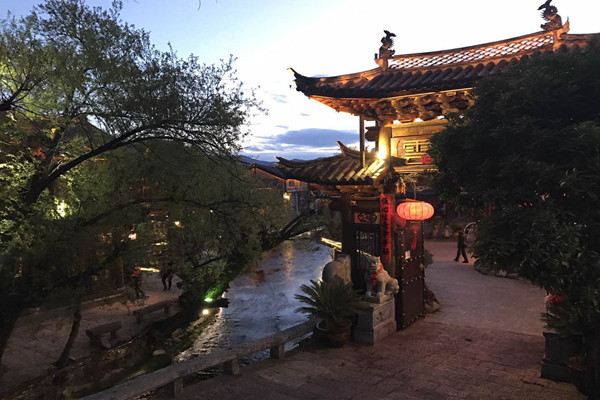Bridges, streams and old abodes: Spring scenes of Yunnan bewitch visitors
- By Wu Jin
 0 Comment(s)
0 Comment(s) Print
Print E-mail China.org.cn, April 26, 2017
E-mail China.org.cn, April 26, 2017
Setting out for a trip in Spring to China’s southwestern province of Yunnan, inhabited with several ethnic minorities, visitors never miss the chance to be intoxicated amid a sea of flowers and unique wooden houses with a history stretching back hundreds of years.
Leg One: Lijiang
Shuhe Ancient Town
|
The gateway of Suhe Ancient Town [Photo by Vigor Scrofa / China.org.cn] |
The wind chimes enshrined with love and blessings hanging on an ancient tree clanged in gentle breezes. Beneath the tree stretch alleyways of slate and cobbles, zigzagging through the community of Shuhe Ancient Town in Lijiang, Yunnan Province. Along the labyrinth of the streets, the rippling streams glistened in the morning sun announcing the coming of a new day.
Sustained by ticket charges and small businesses, such as food, handicrafts, art products, hostels and restaurants, the legacy of the town survives the advent of modern commercialism and impresses visitors with its well-preserved buildings, bridges and creeks, as well as the entire landscape, where the intangible cultural heritage dominated by the Naxi Ethnic Group is housed and protected.
When an evolution from paper pulp to pixels has taken place, it is surprising to find that the ancient handicraft of paper-making in Naxi has endured and continues to flourish with exquisite designs, such as, diaries and paper lamps installed with compact florescent bulbs, an integration between old and new.
Connecting Lijiang, Diqing (where Shangri-la is located) and Tibet, Suhe Ancient Town used to be an important staging post along the Ancient Route of Tea and Horses where caravans traversed precipitous cliffs and roaring rivers to bring parcels of fermented Pu’er Tea by horseback to Tibetan drinkers. The itinerary comprises one of the most courageous, tedious and splendid adventures undertaken by Chinese merchants.
To get more knowledge about the ancient lifestyle in Lijang, one can go against the stream to reach the Museum of Tea and Horses Routes or Dajue Palace, a quadrangle dwelling tucked away in an alleyway. There are plenty of photos, relics and ancient Buddhist murals created as early as the 1580s. In addition to Marco Polo, who mentioned Suhe in his travelogue, Joseph Rock, the Austrian-American geographer and linguist reached Lijiang early in the last century and dedicated himself to the study of Naxi cultures. Moreover, during World War II, the Tea and Horses Route in Lijiang served as a guiding point for Chinese and American pilots flying “The Hump” to break through the blockades built by the Japanese invaders in China.
Dayan Ancient Town
|
The gateway of Dayan Ancient Town [Photo by Vigor Scrofa / China.org.cn] |
An ancient compound established in 1382 on a 369-meter axis was actually an abode of the old magistrate family surnamed Mu in Lijiang. The administration of Mu enjoyed high prestige reflected by the decorations of stone-chiseled dragons that were entitled to have a claw of four fingers, while, the supreme power in Beijing was signaled with five. Built of wood and mud and influenced by both Han and Tibetan culture, the reading hall inside the courtyard stored thousands of volumes of Tibetan Buddhist scriptures while enshrining the divine spirit of Confucius.
Truly understanding the old verities of benevolence and magnanimity, the chief of the mansion built a suspended corridor for his procession when it needed to march among the buildings that connected with external streets. The corridor helped the parade proceed without disturbing the normal operations of the ordinary families on the streets. However, it is interesting that people who cross the corridor need to go back precisely by the same route, otherwise, they are unable to get out of the mansion.
Generally speaking, apart from Confucianism and Tibetan Buddhism, the religious beliefs of the Naxi people can be defined as the consecrated spirit of nature and the souls of creatures under heaven.
Despite the hustle and bustle of the commercial streets replete with bars, restaurants, souvenir shops and accommodation in Dayan Ancient Town, the mansion is a tranquil retreat witnessing the vicissitudes over the centuries.








Go to Forum >>0 Comment(s)